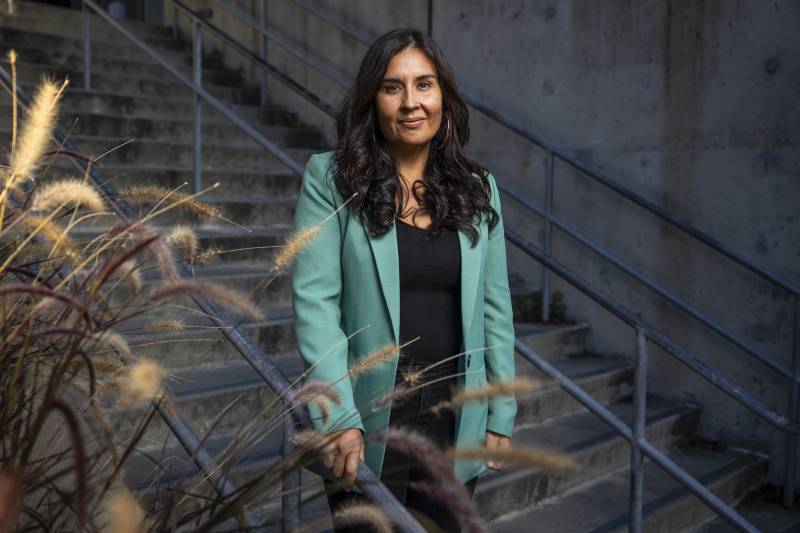At Berkeley and across academia, Latinx college students need institutions to recognize Latinidad as an academic discipline, Mora told me.
Roughly 50% of students who graduate from high school in California are Latino. Meanwhile, Latinos make up about 19% of Berkeley undergraduate students. The university has a goal of reaching 25% by 2027.
However, Latinos only make up 7% of Berkeley’s core faculty. Mora recalled that when she was an undergraduate majoring in sociology, she took a lot of amazing classes that completely left out the Latinx experience.
“I hardly ever got to read texts about my own community,” she said. “I always remember thinking there was this huge gap. I ask myself, ‘What are the things that I can produce and do that I would have loved to read?’”
Mora graduated in 2003 and earned a doctorate in sociology from Princeton University. She is now a tenured professor of sociology and co-director of UC Berkeley’s Institute of Governmental Studies, which conducts research and polls on politics and policy issues. As a Latina in higher education, she feels a duty to also fight against the erasure of our value.
A 2023 report she co-authored found that only 4% of colleges and universities in the U.S. offer a major centered on the Latinx experience. She and her fellow researchers scoured course catalogs for majors such as Latino Studies, Mexican American Studies, Chicano Studies and Puerto Rican Studies.
“It’s incredibly easy for [academia] to write off Latinos as foreigners, as newcomers, as people that live in the outside over there and to overlook the tremendous contributions of Latino communities in the founding history and development of the country,” Mora said.
In the Bay Area, schools such as San Francisco State University and San Jose State University were pioneers in establishing robust Chicano and Latino studies programs, whereas more prestigious schools such as Berkeley and Stanford have lagged, she said.
Many Latinx students go to college to land a well-paying job. So why would it matter if a school offers a Latinx-centered major, given that it may not lead directly into a career?
“The world is complex,” Mora said. “To really understand engineering, you probably need to know society really well, right? You probably need to understand what are the social dynamics around what happens when a freeway is constructed or a bridge is constructed.”
She shared her insights in her office in the social sciences building. I sat on the same couch as dozens of students who had unburdened themselves to her.
Even students not enrolled in her classes, who hear about her through word of mouth, seek her out for guidance and support. They see a part of themselves in her, whether because she’s a child of immigrants or because she, too, had to juggle working multiple jobs while attending Berkeley.
I see some of myself in Mora. We are both in our early 40s, moms and live in the East Bay. I felt like an outsider on my college campus. I want future generations of Latinx students, including my own children, to feel welcomed and represented.
Talking with Mora made me think of how complicated higher education is for many Latinos. On one hand, attending college allows you to access knowledge, pursue careers, achieve financial stability and become a more conscious member of society. On the other hand, you might feel like you have to find a way to blend in or constantly feel at odds with your surroundings.
When I attended Vanderbilt University 20 years ago, the percentage of Hispanic students was 3.4 to 4.1% (now close to 12%). I majored in English and minored in Latin American Studies, with an emphasis on Mexico.
The only class I took that centered on the Latino experience in the U.S., as opposed to Latin America, was a Latino literature course taught by acclaimed Puerto Rican writer Judith Ortiz Cofer, who was a visiting professor. It exposed me to a world of writers I had never encountered and showed me that Latino literature was a thriving genre.
Chicana writer Lorraine Lopez was the only professor who encouraged me to go to graduate school. I earned a master’s in creative writing from Mills College.
I mention all of this to second what Mora told me: The ability for students to see themselves reflected in faculty and course material isn’t the be-all and end-all, but it can lead to meaningful, life-altering connections.
What I really admire about Mora is that she is focused on changing how Latino students experience higher education in ways that benefit non-Latino students and faculty, too. Still, revamping any longstanding, powerful institution is challenging and daunting. I asked what keeps her going.
“I don’t have an option but to keep pushing,” Mora said. “I’ve had the chance to move to the East Coast or become a professor at an elite private school. I choose to stay here, and many of my colleagues choose to stay here.
“We stay here because we believe in teaching the students here. We believe in the future of California. We believe that this place can be better.”

